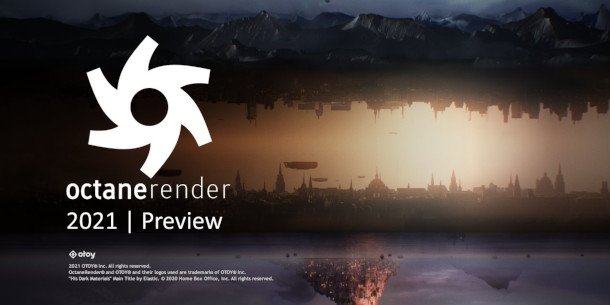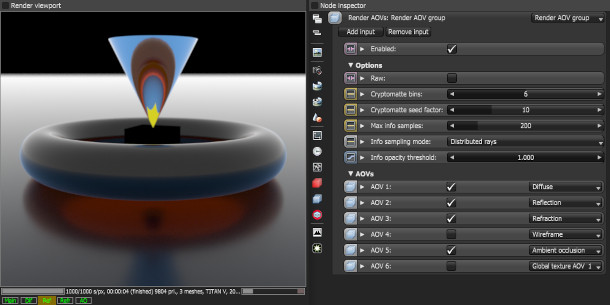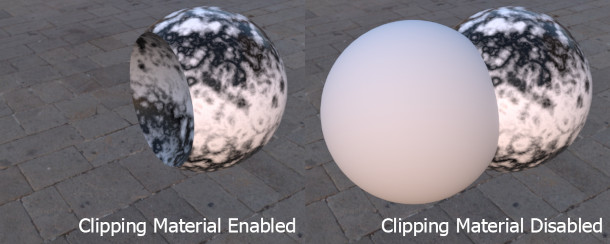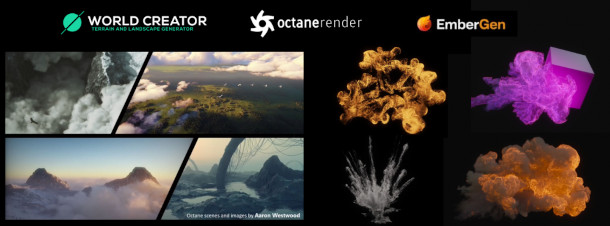Otoy unveils OctaneRender 2020.2 and 2021

Otoy has unveiled OctaneRender 2021, a major update to the GPU renderer that overhauls the AOV system, improves performance on new Nvidia Ampere GPUs, and adds support for Hydra render delegates.
The release is currently in closed beta, and isn’t due to ship until after OctaneRender 2020.2.
The firm has also announced RNDR+, a new subscription package that bundles OctaneRender with 10 render node licences and full copies of gaseous fluid simulator EmberGen and terrain generator World Builder.
Octane 2020.2: improved RTX rendering, nested dieletrics and OpenColorIO management
Before we get to OctaneRender 2021, it’s worth noting that it isn’t the next version of OctaneRender due to ship: that’s OctaneRender 2020.2.
When it was announced at Nvidia’s GTC conference in April, Otoy described it as focusing on performance and stability, particularly when using the new hardware-accelerated ray tracing system.
Introduced in the OctaneRender 2020.1, RTX acceleration enables OctaneRender to use the dedicated ray tracing cores in Nvidia’s current-gen RTX GPUs to accelerate renders.
According to Otoy, the goal in 2020.2 is for users “never to have to turn the RTX flag off any more”: that is, always to render with RTX acceleration enabled, regardless of the complexity of a scene.
When the first experimental release of OctaneRender 2020.2 became available in September, Otoy summarised its other features as follows:
- Fast spectral nested dielectrics
- ACEScg and filmic processing
- OpenColorIO management, display and export (OCIO profile)
- OpenColorIOColor graph nodes – Look, Profile and View nodes
- Integrated multi-scatter nodes – Vectron Scatter, Volume Scatter and Surface Scatter*
- User-generated compositor AOV passes for combining render and light passes in full a compositor node graph*
- Nested compositor operator nodes*
- Built-in Vectron primitives and operators*
- Built-in ray type, utility, RGB channel, math and color operator nodes*
- Chaos Texture tile system*
- Built-in multi-light, fast fog, and wireframe post processing in Imager node*
- UV distortion map textures*
- Gradient node improvements*
Features with asterisks weren’t present in the initial XB1 release, and were due to be added in later builds.
The new surface scatter and volume scatter tools and AOV compositing tools were added in the XB4 release, channel and ray type nodes in XB5, and the Chaos Texture node in RC1.
We can’t find any reference to changes to the Imager node, UV distortion map textures or gradient node in any of the subsequent changelogs, so we can’t confirm whether they were added.
However, Otoy says that the current build – at the time of writing, Release Candidate 3, is now feature-complete – and that no further features will be added before the stable release.

OctaneRender 2021: new system of custom render AOVs
As has happened in the past, Otoy’s press release for OctaneRender 2021 repeats some of the features from the previous version: in this case, OpenColorIO and ACEScg.
However, there is plenty that is entirely new, including a reworking of the render AOV system.
A new system of render AOV group nodes enables users to add an arbitrary number of inputs, then connect specific render AOV nodes to them, making it possible to create custom AOVs.
Render AOV groups can be nested, and whole groups enabled or disabled in one go.
It is also now possible to apply a texture or OSL shader to an entire scene, including or excluding the environment, and render that texture or shader as an info AOV.

OctaneRender 2021: new shader-based Boolean clipping system
There is also a new shader-based Boolean clipping system, which enables users to apply a clipping material to a volume, mesh or Vectron formula and use it for Boolean subtractions.
Unlike conventional Boolean modelling, the new surfaces this creates can be filled automatically with the parent object’s material or textures, using the clipping material’s UV set.
Other new features include volumetric light linking, making it possible to specify light exclusion for mediums and volumes.
OctaneRender 2021: performance improvements and better out-of-core rendering
Performance improvements include updates to OctaneRender’s AI Light algorithm, which Otoy says reduces noise in beauty passes and accelerates final-frame renders by “2x or more”.
Deformation motion blur and motion blur on animated instances is now “1.5x faster” when rendering on Nvidia’s latest Ampere GPUs.
OctaneRender 2021 also features improvements to volumetric rendering and when rendering out-of-core, improving performance when rendering scenes too large to fit into GPU memory.
New multi-render system will let users run other render engines inside OctaneRender
In addition, OctaneRender 2021 will feature Otoy’s much-anticipated multi-render system, which enables users to swap between Octane itself and any supported third-party renderer.
It is based on the system of Hydra render delegates developed by Pixar for usdview, its open-source viewer for the Universal Scene Description format.
OctaneRender supports “standard Hydra tender delegates”, which usually means Arnold, RenderMan and AMD’s Radeon ProRender, plus Blender’s Cycles renderer.
That should make it possible to use render engines inside DCC applications that they don’t support natively, but which OctaneRender does: for example, Arnold in Blender, or Cycles in Maya.
The multi-render system will also support Otoy’s own other render engines, Brigade and AnimeRender.
The former is a real-time path tracer originally integrated into OctaneRender 4.0, although the multi-render version has been rebuilt and sounds significantly more powerful: at GTC, Otoy CEO Jules Urbach described it as “our version of Eevee”, Blender’s native real-time renderer.
The latter is a cel-shading renderer originally announced in 2018 but still not publicly available.

New RNDR+ subscription package
In addition to OctaneRender 2021, Otoy has announced RNDR+, a new subscription package.
It provides the same features as the existing Enterprise subscription, plus 10 render node licences, and 10,000 OctaneBench-hours of cloud rendering via Otoy’s RNDR render network.
Users also get full commercial licences of gaseous fluid simulation tool EmberGen and terrain generator World Creator, Otoy having partnered with their creators JangaFX and BiteTheBytes earlier this year.
RNDR+ subscriptions are currently available only as annual packages at a “limited-time Black Friday discount”, but will eventually cost €479.40/year (around $580/year), or €49/month (around $60/month).
The ins and outs are quite complex, so for full details, and for more information about the planned integrated versions of EmberGen and World Creator, check out this forum thread.
Pricing and system requirements
OctaneRender 2021 is available in closed beta: according to this forum post, you can apply to join the beta by emailing help@otoy.com with ‘2021 Preview’ in the subject line.
OctaneRender 2020.2 is currently available as a release candidate, which should mean that it is within a month or two of a stable release, based on Otoy’s past release history.
The current stable build, OctaneRender 2020.1, is available for 64-bit Windows 7+, Linux and macOS 10.12+. Integration plugins are available for 21 DCC applications.
The core software requires a CUDA 10-compatible Nvidia GPU (Compute Capability 3.x+); the RTX rendering mode requires a newer Nvidia GPU.
Otoy is also developing a separate macOS version, Octane X, which supports the AMD GPUs in current Macs. At the time of writing, it is still a public preview.
Enterprise box licences – perpetual licences for the standalone edition and one integration plugin, plus subscription access to the remaining plugins – currently start at €699.
Subscriptions give access to all of the plugins and cost €19.99/month or €199/year for use on up to two GPUs, or €29.99/month or €299/year for unlimited GPUs. The new RNDR+ subscriptions are covered above.
The Blender, DAZ 3D, Unity and Unreal Engine plugins are available free for use on a single GPU via OctaneRender Prime. Prime does not include OctaneRender standalone, or support network rendering.
